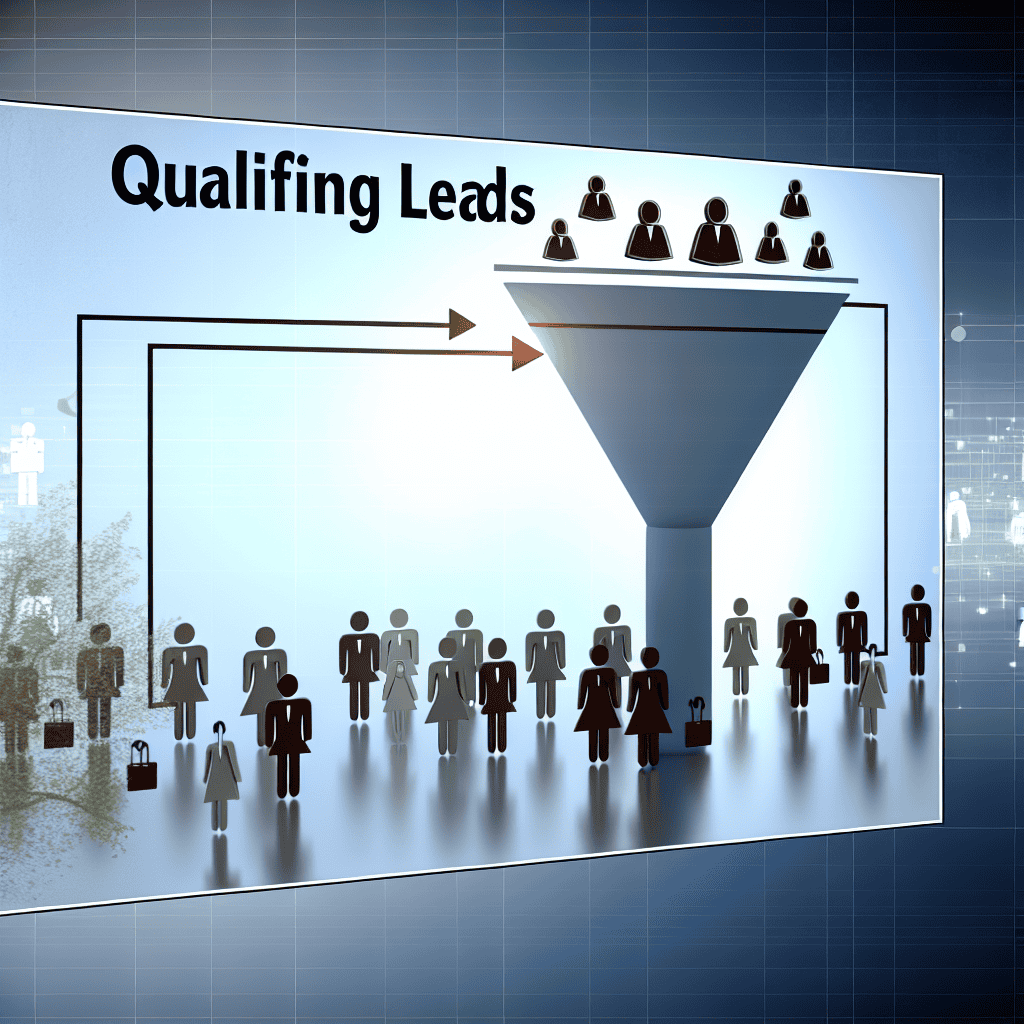How to Qualify Leads: A Comprehensive Guide for Small Business Success
Attention, fellow entrepreneurs and business leaders! Are you tired of chasing leads that go nowhere? Did you know that 96% of website visitors aren’t ready to buy? That’s right—your sales team could be wasting valuable time on unqualified prospects. But fear not! I’m here to show you how to qualify leads like a pro.
Interested in supercharging your sales process? Imagine a world where your sales and marketing teams work in perfect harmony, effortlessly identifying high-quality leads primed for conversion. It’s not just a pipe dream – it’s entirely possible with the right lead qualification frameworks.
By the end of this guide, you’ll be itching to implement these game-changing strategies. So, are you ready to transform your business and skyrocket your success? Let’s dive in and master the art of lead qualification!
What is Lead Qualification?
Lead qualification involves evaluating potential customers to determine their likelihood of making a purchase. This process saves valuable time and resources and allows you to tailor your marketing and sales strategies to the needs of high-potential clients.
Simply put, lead qualification evaluates potential customers to determine their likelihood of purchasing. Think of it like a filter that helps you identify the “hot” leads from the “cold” ones. By focusing on marketing qualified leads, you can improve your conversion rates, boost sales productivity, and ultimately drive more revenue for your business.
Why You Should Master How to qualify leads
Lead qualification isn’t just a fancy sales term—it’s a game-changer for your small business. Mastering this skill can transform how you approach sales and see tangible results.
Increased efficiency in sales efforts
Imagine spending less time on dead-end leads and more time closing deals. Lead qualification lets you prioritize the most promising prospects, streamline your sales pipeline, and avoid wasting valuable resources on leads that are unlikely to convert.
Higher conversion rates
You’re targeting individuals already interested in your products or services. This increases your chances of converting them into paying customers, leading to a higher return on your sales and marketing investments.
Better allocation of resources
Lead qualification enables you to allocate your resources strategically. Instead of spreading yourself thin, you can concentrate on nurturing relationships with the leads that matter most, maximizing your chances of success.
Improved customer satisfaction
When you engage with qualified leads, you’re more likely to provide them with a personalized and relevant experience. This increases customer satisfaction, fosters long-term relationships, and generates positive word-of-mouth referrals.
The Ultimate Guide: How to Qualify Leads
Effectively qualifying leads isn’t about guesswork—it’s about having a structured approach. GPCTBA/C&I stands for Goals, Plans, Challenges, Timeline, Budget, Authority, Consequences, and Implications.
This comprehensive lead qualification framework helps you gather essential information about a lead’s situation, needs, and decision-making process, enabling you to tailor your sales approach accordingly.
Step 1: Identify the Goals (G)
Every lead has a reason for engaging with your business. They’re seeking a solution to a problem, aiming to achieve a specific outcome, or simply exploring their options. Your job is to uncover that underlying motivation – their “why.”
- What are they trying to achieve? Are they looking to increase revenue, improve efficiency, or enhance customer satisfaction?
- What problems are they looking to solve? Are they struggling with outdated technology, a lack of resources, or a complex process?
- What pain points are keeping them up at night? What challenges are hindering their progress or causing frustration?
When you actively listen to your leads and ask insightful questions, you gain a deep understanding of their goals and motivations. This information is invaluable for tailoring your approach and demonstrating how your product or service can directly address their needs.
Step 2: Determine the Plans (P)
After initially identifying a potential lead, the next crucial step is to assess their plans—understanding what they intend to achieve and how your product fits into those plans. This isn’t about merely knowing if they have the budget but aligning your offerings with their strategic goals.
- Engage in Meaningful Conversations: Start by engaging them with questions that delve deeper into their business objectives. What are their short-term and long-term goals? How do they envision using your solution to solve their problems?
- Align Features with Needs: Each product feature should correspond to a specific lead need. Detail how your product’s capabilities align perfectly with their projects and expected outcomes.
- Customize Solutions: Flexibility in adapting your services to meet their unique demands is key. Personalized experiences resonate well with leads who feel understood and valued.
- Provide Evidence: Back up your claims with data, case studies, and testimonials. Demonstrative proof of your product’s efficiency in similar contexts can significantly boost the lead’s confidence in your solution.
By meticulously determining your leads’ plans, you not only increase the likelihood of conversion but also build a foundation for enduring customer relationships. Tailoring your approach based on detailed understanding ensures that your interactions are always relevant and impactful.
Step 3: Assess Challenges
Every journey has its obstacles, and your leads’ path to success is no different. It’s essential to delve deeper and understand the challenges they face in achieving their goals.
- What hurdles are they encountering?
- Are there internal or external factors hindering their progress?
- Have they tried other solutions that didn’t work?
The more you identify their pain points and roadblocks, the more you can tailor your messaging to showcase how your solution overcomes those specific challenges. This positions your offering as a valuable asset that can help them navigate their obstacles and ultimately achieve their desired outcomes.
Step 4: Establish Timeline (T)
Understanding a lead’s timeframe is crucial for effective lead qualification. This step helps you gauge the urgency of their needs and align your sales process accordingly.
Some leads may need a solution immediately, while others might be in the early stages of exploration. By determining their timeline, you can prioritize leads that require immediate attention and avoid wasting time on those who are not yet ready to make a decision.
It’s important to set realistic expectations with your leads regarding the implementation and onboarding process. This ensures that everyone is on the same page and helps you avoid potential frustrations or delays down the line.
Establishing a clear timeline and understanding the urgency of a lead’s needs can help you tailor your approach and provide a seamless experience that leads to successful conversions.
Step 5: Evaluate Budget (B)
Let’s face it, budget plays a significant role in any purchasing decision. It’s crucial to understand your lead’s financial capacity and ensure that your solution fits within their budgetary constraints.
- What’s their budget for addressing this need?
- Are they willing to invest in a premium solution?
- Do they have the financial resources to commit to your offering?
Having open and transparent conversations about budget can avoid wasting time on leads who simply can’t afford your product or service. It also allows you to tailor your recommendations and pricing options to match their financial capabilities, increasing the likelihood of a successful sale.
Step 6: Identify the Authority (A)
Identifying the decision-maker within an organization is a critical step in the lead qualification process. Knowing who has the authority to make purchasing decisions can save you time and direct your efforts more efficiently.
- Direct Engagement: When you connect with a prospect, ensure you are speaking with the person who can decide or influence decisions regarding purchasing your product. This can often be determined through direct questions or by researching role responsibilities within the company.
- Leverage LinkedIn: Use platforms like LinkedIn to understand the company’s hierarchical structure. This can help you identify key stakeholders and understand their organizational roles and influence.
- Tailored Communication: Once you know who the authority is, tailor your communication to address their concerns and explain how your product can solve their problems. This approach streamlines the sales process and enhances the effectiveness of your pitch.
- Educate and Inform: Offer valuable insights and data that empower the decision-maker to advocate for your solution internally. Case studies, ROI calculations, and testimonials can equip them with the necessary tools to justify the investment.
- Follow-Up Strategically: Stay in touch with the decision-maker through thoughtful follow-ups that reinforce the value of your product and any new features or benefits that may interest them. Consistent engagement is key to maintaining interest and moving towards a sale.
This step ensures that your efforts are concentrated on the individuals who can make a tangible impact on your sales outcomes, aligning perfectly with the strategic goals of your business and your potential clients.
Step 7: Determine Negative Consequences
This is where you dig a bit deeper into the potential pain points your prospect faces if they don’t solve their problem. Remember, you’re not trying to scare them, just highlighting the cost of inaction.
Think of it like this: every problem has a ripple effect. If a leaky roof isn’t fixed, it leads to water damage, mold, and potentially structural issues. In the business world, the consequences might be missed sales opportunities, decreased productivity, or even losing customers to competitors.
To uncover those consequences, you need to ask probing questions. Here are a few examples:
- “What happens if you don’t address this issue in the next six months?”
- “How is this problem impacting your team’s morale or efficiency?”
- “Have you calculated the financial cost of not solving this problem?”
Pay close attention to their answers. You’re not just gathering information but building rapport and showing that you genuinely understand their challenges. This empathy goes a long way in establishing trust.
Once you have a clear picture of the negative consequences, connect them back to your solution. Show how your product or service can help them avoid those pain points and achieve their goals.
Example:
- Prospect: “If we don’t improve our customer support, we risk losing valuable clients to our competitors.”
- You: “I understand. Our platform streamlines customer interactions, ensuring faster response times and increased satisfaction. This helps you retain clients and even attract new ones.”
Remember, It’s About Helping, Not Selling.
The goal here isn’t to pressure your prospect into a sale. It’s about demonstrating that you understand their challenges and have a solution to make a real difference.
Step 8: Positive Implications (I)
Alright, let’s shift gears and talk about the positive side of things — the ‘I’ in BANT, which stands for Positive Implications. This is where you paint a picture of the brighter future your prospect can achieve by addressing their challenges.
Think about it: every solution brings positive outcomes. A new CRM system might lead to improved customer relationships and increased sales.
A streamlined inventory management process could result in cost savings and greater efficiency. Your job is to uncover and articulate these potential benefits to your prospect.
To get the conversation flowing, here are some questions you can ask:
- “What would it mean for your business if you could solve this problem?”
- “How would addressing this issue impact your bottom line?”
- “What goals would you be able to achieve if this challenge was no longer an obstacle?”
As your prospect responds, truly listen. Try to visualize the positive impact your solution could have on their business. The more vividly you can paint this picture, the more compelling it will be.
Connect the benefits to their specific aspirations. Perhaps they’ve mentioned wanting to expand into new markets or improve employee satisfaction. Show them how your product or service can help them turn those dreams into reality.
Example:
- Prospect: “If we could automate our marketing efforts, we’d have more time to focus on strategic initiatives and innovation.”
- You: “Absolutely. Our marketing automation platform can handle those repetitive tasks, freeing up your team of sales reps to focus on the big picture. Imagine the possibilities that open up for your business!”
This step is all about inspiring your prospect and showcasing the possibilities. It’s about showing them a path to success and making them excited about the journey ahead.
Implementing a Lead Scoring System to Qualify leads
Think of lead scoring as your business’s very own matchmaking system. Instead of swiping left or right, you’re assigning points to potential customers based on how well they align with your ideal customer profile. This way, you can focus your energy on the leads with the highest chance of turning into happy, paying clients.
Creating Your Lead Scoring Model
Building a lead scoring model is like crafting a recipe – you need the right ingredients in the right proportions. Let’s explore some of the key elements to consider:
1. Demographic Data
- Industry: Do they operate in a sector that typically benefits from your solution?
- Company Size: Is their organization a good fit for your product or service in terms of scale?
- Location: Are they in your target market geographically?
2. Online Behavior
- Website Visits: Have they visited specific pages on your website that indicate interest (e.g., pricing, product demos)?
- Content Downloads: Have they downloaded any of your resources (e.g., white papers, ebooks)?
- Email Engagement: Are they opening and clicking on your emails?
3. Social Engagement
- Social Media Follows: Are they connected with you on social platforms?
- Likes and Shares: Do they interact with your content on social media?
4. Lead Source
- Referral: Did they come from a trusted source (e.g., a partner existing client)?
- Organic Search: Did they find you through a search engine, indicating they’re actively looking for a solution?
5. Negative Attributes
- Competitor Inquiries: Have they expressed interest in your competitors?
- Low Engagement: Have they shown little to no interaction with your brand?
- Job Role: Are they in a position to influence the buying process decision?
Assigning Point Values
Once you’ve identified these factors, you’ll need to assign point values to each. This requires some careful thought and analysis. Here are some tips:
- Start Simple: Begin with a basic model and refine it over time.
- Consider the Sales Cycle: Adjust scores based on the typical length of your sales process.
- Test and Iterate: Regularly review your model and make adjustments based on performance.
Once your lead scoring model is in place, it’s time to let it work its magic! Your sales team can now focus on the leads with the highest scores, maximizing their chances of closing deals and boosting your bottom line.
Automating Your Lead Qualification Process
Alright, let’s face it—manually sifting through leads is about as fun as watching paint dry. Thankfully, we live in an age of automation. Let’s explore how you can put technology to work and streamline your lead qualification process.
Why Automate?
Automation isn’t just about saving time (though that’s a huge perk). It’s about ensuring that every lead gets the attention they deserve right when they need it. With automation, you can:
- Respond Instantly: Capture leads’ interest while they’re hot.
- Nurture Relationships: Deliver targeted content to move leads through the sales funnel.
- Score Leads Accurately: Consistently apply your lead scoring model, eliminating human bias.
- Alert Sales at the Right Time: Notify your team when a lead is ready for a conversation.
Tools of the Trade
Several tools can help you automate your lead qualification process. Here are a few popular options:
- Customer Relationship Management (CRM) Systems: These powerhouses track interactions, manage leads, and often include built-in lead-scoring capabilities.
- Marketing Automation Platforms: These platforms help you create and automate email campaigns, landing pages, and other marketing initiatives to nurture leads.
- Lead Scoring Software: These specialized tools focus specifically on scoring leads based on your criteria.
The Automation Flow
Here’s a glimpse into how automation can work its magic:
- Lead Capture: A visitor fills out a form on your website, triggering an automated welcome email.
- Lead Nurturing: The lead receives a series of targeted emails, providing valuable information and building trust.
- Lead Scoring: Their interactions with your content (email opens, clicks, website visits) are tracked and scored.
- Sales Alert: Once the lead reaches a certain lead score threshold, an alert is sent to your sales team, signaling it’s time to make contact.
Remember: It’s About Balance
Automation is powerful, but it’s important to strike the right balance. You still want to provide a human touch and personalized experiences. Use automation to handle the repetitive tasks, freeing up your team to focus on building meaningful relationships.
Aligning Sales and Marketing Teams for Effective Lead Qualification
Let’s be honest, sometimes it feels like sales and marketing are speaking different languages. But when it comes to lead qualification, these two sales teams need to be in perfect harmony. A well-oiled machine ensures no lead falls through the cracks and that every opportunity is maximized.
Importance of Sales and Marketing Alignment
Think of sales and marketing as two sides of the same coin. Marketing attracts and nurtures leads, while sales closes the deal. When they’re aligned, it’s like a beautiful dance – seamless and effective. This alignment leads to:
- Higher Quality Leads: Marketing delivers leads that are truly sales-ready.
- Shorter Sales Cycles: Sales spend less time chasing unqualified leads.
- Increased Revenue: More sales-qualified leads translate to more closed deals.
Strategies for Improving Communication
Communication is key to any successful relationship, and the same goes for sales and marketing teams. Here are a few strategies to foster better communication:
- Regular Meetings: Schedule weekly or bi-weekly meetings to discuss lead generation, qualification, and any challenges.
- Shared Tools: Utilize a CRM system that both teams can access to track lead progress and share insights.
- Feedback Loops: Encourage open communication and feedback between the two teams.
Shared KPIs and Goals
When sales and marketing are working towards the same goals, they’re more likely to collaborate effectively. Establish shared key performance indicators (KPIs) that reflect the success of both teams, such as:
- Number of Qualified Leads: Focus on quality over quantity.
- Conversion Rates: Track how many leads turn into customers.
- Revenue Generated: The ultimate measure of success.
The Role of Content in Lead Qualification
Content isn’t just about attracting eyeballs – it’s a powerful tool for qualifying leads. By creating targeted content and tracking engagement, you can gain valuable insights into a lead’s interests and pain points.
Creating Targeted Content for Each Stage of the Buyer’s Journey
Different types of content resonate at different stages of the journey for the economic buyer. Here’s a quick overview:
- Awareness Stage: Blog posts, infographics, social media content
- Consideration Stage: Ebooks, white papers, webinars
- Decision Stage: Case studies, testimonials, product demos
Using Content Engagement as a Qualification Metric
Pay attention to how leads interact with your content. Are they downloading your ebooks? Attending your webinars? This engagement signals interest and can help you identify high-quality leads.
Leveraging Social Media for Lead Qualification
Social media isn’t just for cat videos and memes. It’s a valuable platform for connecting with potential customers and gathering information about their needs and interests. Monitor social media conversations, track engagement with your brand, and use these insights to qualify leads.
Effective lead qualification is a team effort. By aligning sales and marketing, leveraging content, and using automation strategically, you’ll transform your entire lead qualification process into a well-oiled machine. Remember, it’s not just about generating leads—it’s about finding the right leads and nurturing them into loyal customers.
Key Considerations for Successfully Qualifying Leads
Qualifying leads isn’t a one-and-done deal. It’s an ongoing process that requires constant refinement. As your business evolves and your target market shifts, so should your lead qualification, which is an important criterion. Regularly review your process, analyze your data, and make adjustments as needed to ensure you’re always focusing on the most promising leads.
Data is your best friend when it comes to lead qualification. By tracking and analyzing key metrics, you can gain valuable insights into your lead-generation efforts and identify areas for improvement. Use this data to make informed decisions about your lead qualification process, ensuring you’re always optimizing for success.
While automation can be a powerful tool, it’s important to remember the human element. Don’t let technology completely replace personal interactions. Strike a balance between automation and human touch to create a lead qualification process that’s both efficient and engaging.
Taking it to the Next Level: Advanced Lead Qualification Techniques
Ready to step up your lead qualification game? Here are some advanced techniques to consider:
Predictive lead scoring uses machine learning algorithms to analyze historical data and predict which leads are most likely to convert. This can help you prioritize your efforts and focus on the leads with the highest potential.
An account-based marketing (ABM) approach focuses on targeting specific, high-value accounts. By tailoring your marketing and sales efforts to these accounts, you can increase your chances of success and maximize your return on investment.
Multi-touch attribution tracks the various touchpoints a lead has with your brand before converting. This can help you understand which marketing channels and campaigns are most effective at generating qualified leads.
Alternatives to Traditional Lead Qualification Methods
If traditional lead qualification methods aren’t delivering the results you’re looking for, consider exploring some alternatives:
Inbound marketing focuses on attracting leads through valuable content and experiences. By providing helpful information and resources, you can attract qualified leads who are already interested in what you have to offer.
Product-led growth puts your product front and center, allowing potential customers to experience its value firsthand. By offering a free trial or freemium version, you can attract leads who are more likely to convert into paying customers.
Community-based qualification leverages the power of your community to identify and nurture leads. By fostering an engaged community around your brand, you can identify potential customers and build relationships with them organically.
Conclusion: Mastering Lead Qualification for Business Growth
Let’s take a moment to recap the essential strategies we’ve explored on this lead qualification journey. We’ve delved into understanding your ideal customer profile, leveraging the GPCTBA/C&I as a lead qualification framework, implementing lead scoring, fostering sales and marketing alignment, and even venturing into advanced techniques and alternative qualification methods.
Now, it’s time to put this knowledge into action. Don’t let these strategies remain mere concepts—embrace them, experiment, and refine them to perfectly suit your unique business needs. Remember, lead qualification isn’t about casting a wide net; it’s about strategically targeting the right fish.
The business landscape is constantly evolving, so your approach to lead qualification should too. Keep learning, stay curious, and always be on the lookout for new and innovative ways to connect with your ideal customers.
If you’re hungry for more insights and tips, feel free to explore our other resources and guides. We’re here to support you every step of the way as you grow your business and achieve your goals.
Remember, success in business often hinges on the quality of your leads. By mastering the art of lead qualification, you’ll unlock a world of opportunities and pave the way for sustainable growth. So, go out there and make it happen!
Final Thoughts on the technique to qualify leads
There you have it – a deep dive into the world of lead qualification. We’ve covered everything from understanding the fundamentals to implementing advanced techniques. Remember, the goal isn’t just to generate leads but to attract the right leads, those who are genuinely interested in your product or service and have the potential to become long-term customers.
By mastering lead qualification, you’ll empower your sales team to focus their efforts on the most promising opportunities, ultimately boosting your conversion rates and driving revenue growth. Don’t be afraid to experiment with different approaches and find what works best for your business. The key is to be consistent, data-driven, and always focused on providing value to your potential customers.
Remember, lead qualification is an ongoing journey, not a destination. Stay curious, adapt to the ever-changing landscape, and never stop refining your strategies. By investing the time and effort to master this crucial aspect of your sales process, you’ll set your business up for long-term success.
Now, go out there and start qualifying those leads like a pro!







